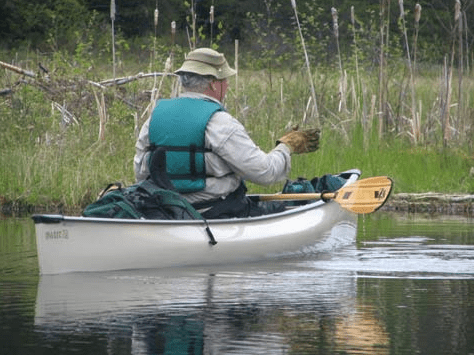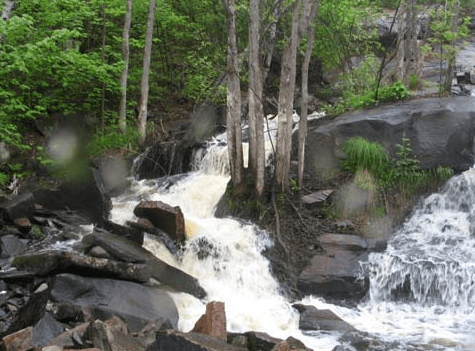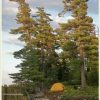Canoeing the Quetico: Living the Experience
French/ Pickerel/ Sturgeon/ Quetico/ Cirrus/ Beaverhouse Shuttle Route – Fall 2008
I was first introduced to the mysteries of the Quetico Park in 1969 at the age of 16 on a Region 10 Explorer Scout trek out of Sommers Canoe Base – a loop through Moose Lake / Man Chain / Kawnipi / Kahshahpiwi. Last fall, my fortieth (nearly consecutive) year canoeing brought the opportunity to return on a solo, a meditative retreat over nine days making entry via shuttle to the French Lake / Dawson Trail access, through the northern half of the Quetico, and exiting out through Beaverhouse. The route would be east – west, typically reserved for certifiably loony canoeists bent on paddling against prevailing westerly winds for hours at a time across major bodies of water (Pickerel, Sturgeon, Quetico, Cirrus). Well ok, let the Wind Spirits toy with me – laughing hysterically no doubt! Permit in the file and the shuttle arranged, the trip was in-the-can for August 15 – 23, 2008. Dreaming of it during wintry Minnesota nights would entertain me in giddy anticipation of another deep-wilderness Quetico trek.
 Physical preparation in the gym comprised of alternating weights and cardio routines; and outside, cross-country skiing and biking. About six weeks prior to departure, I trained with my family’s old 1964 AlumaCraft 17 1/2’ canoe that weighs in around 85 lbs. (can you spell “rivets”?) 3 times a week over hill and dale around the park near our home. This peculiar spectacle would occasionally elicit an entertaining exchange with Frisbee golfers and park-goers, usually ending with the peace sign as I trod along. My purpose was clear – a compelling desire to prepare for the physical rigors of deep wilderness solo canoe trekking at age 55.
Physical preparation in the gym comprised of alternating weights and cardio routines; and outside, cross-country skiing and biking. About six weeks prior to departure, I trained with my family’s old 1964 AlumaCraft 17 1/2’ canoe that weighs in around 85 lbs. (can you spell “rivets”?) 3 times a week over hill and dale around the park near our home. This peculiar spectacle would occasionally elicit an entertaining exchange with Frisbee golfers and park-goers, usually ending with the peace sign as I trod along. My purpose was clear – a compelling desire to prepare for the physical rigors of deep wilderness solo canoe trekking at age 55.
Wilderness-Think: “Living the Experience”
The difference between ‘just going on a canoe trip’ and ‘living the experience’ lies in both the physiological and psychological realms. In city life, we are consumed everyday by computers, cell phones, a controlled climate, cement and tarmac, roadway annoyances, unavoidable stress in family and business life, transporting by car and sitting at our desk, living every day hostage to and controlled by our daily planner, watches and clocks…the prototypical “Urban Self”.
Wilderness life turns all of this on its head. No watches – no ‘man time’ here. Living in the wild for anything more than a few days requires us to literally relinquish ourselves physically and psychologically to the natural order of things: the heat, the cold, the wet, the dry, the heart pounding portage, camp chores for all things needed, hours against 20 knot winds. There is nowhere to escape to in the wild other than our tent or under the R fly (ah, the R word remains unspoken). We shed our “Urban Selves” and all of our senses become honed. We become one with the animals and environment. We are ‘living the experience’ – cleansing our spirits.
This is the beauty of it – these natural rhythms and living in the exposure of the natural world. Our time is our own – get up with dark gray tent walls or sleep in; stop on a mid-lake rock pile for some rest and a snack; throw out a Rapala on this blackwater shoreline stretch – we choose at our own whim. We watch wind changes and understand ‘normally’ what happens with high pressure systems (stable prevailing westerly winds, gray puffers signaling the typical one-hour afternoon R squall); what happens with low pressure systems (winds shifting counterclockwise to N’easterly, ballooning thunderheads, colder temps, and stormy weather coming); and what happens with southerly winds (warm temps, sometimes warm R – no need for R gear, enjoy it!). We know where the fish are in the spring and in the fall. Studying maps and navigating through the wilderness whatever the next lake and next portage bring us – we are living “The Adventures of Tom Sawyer and Huckleberry Finn”!
Paddling through the creeks and swamps isn’t a sweaty, muddy chore teetering on beaver dams in a humid pungent mosquito-infested vacuum. It’s all in how we think about it. This is a spectacular, rare experience in this wild setting of incredible ecology. The very essence of life is all around us as we lurch through the Lilly pads, touching them with our fingertips at the end of our stroke for just a moment. How can we not stop here, in total silence and stillness, swamp grass a foot off the gunwale, absorbing the mystery and the complexity all about us? Living the experience – this moment. 
Trees, of course, dominate the visual experience in canoe country and how beautiful and interesting they are. Big reds and cedars at the waterline (roots and limbs like tangled water convection tubes) are my favorites. Who can resist the magnificence of the stately whites or the brilliant illumination of a birch stand in the moonlight? Is this just ‘a tree is a tree’ as we pass by, same-ol’ same ol’? Or is the appreciation of these images in the wild something we absorb into our spirit forever? Even in death, be it windblown, an aged fall, or a lightning strike, the rotting wood provides for colonies of insects and critters about, feeding life afoot and a-flight. They aren’t ‘just trees’. We are witness to their magnificence.
We respect every plant, every animal we encounter. Even the joy of releasing a walleye a foot off the tumblehome by snapping it free in the water with a quick twitch on a barbless hook requires a moment of deep satisfaction, almost humility. How do you explain the psychological warmth watching a release flash its tail and disappear into the depths? A very special moment, not something ‘we just did’… at one with it, at peace with it. Living the experience – respect and harmony.
Anishinaubae Spirituality
I believe in the Indian ways in the woods and this is Anishinaubae country (my preference, meaning ‘good beings whose intent is good’; also Ojibway). Read the most wonderful book “The Manitous” by Basil Johnston for more on the basics of Anishinaubae spirituality.
 The Anishinaubae believed in a spiritual world (“manitous”) that influenced their lives daily and that these spirits were always about. Alternatively, we might consider these spirits our guardian angels. Regardless, I would take a moment facing the east in the morning and the west in the evening, to offer a prayer to the spirits, thanking them for the day and night they gave me; to guide me, to influence my thinking and my choices; and to protect me moment-by-moment in my travels. They were indeed all about me on the trails (e.g. concentrating on lifting my trailing foot stepping over 1,000 exposed roots on a portage); and upon the waters (as I carefully made adjusting twists with my single-blade surfing 3 footers).
The Anishinaubae believed in a spiritual world (“manitous”) that influenced their lives daily and that these spirits were always about. Alternatively, we might consider these spirits our guardian angels. Regardless, I would take a moment facing the east in the morning and the west in the evening, to offer a prayer to the spirits, thanking them for the day and night they gave me; to guide me, to influence my thinking and my choices; and to protect me moment-by-moment in my travels. They were indeed all about me on the trails (e.g. concentrating on lifting my trailing foot stepping over 1,000 exposed roots on a portage); and upon the waters (as I carefully made adjusting twists with my single-blade surfing 3 footers).
The Anishinaubae revered the earth for it provided for them. It must not be exploited beyond their daily needs, and be replenished and sustained. Thanks were given daily to Muzzu-Kummik-Quae, “Earth Mother” in all her forms and manifestations, for providing for their very sustenance. Giving back to sustain the earth was a major premise in their lives and in their actions of deep respect for Muzzu-Kummik-Quae…and so it shall be our premise and our actions in the wilderness. We will think it; believe it; respect it; live it.
Closing
At home once again in this urban world of stress and deadlines but with much of my spirit deeply ingrained in Canoe Country, in closing here is an excerpt from “The Manitous”:
“Whether they were stalking their quarry or estimating the quality and quantity of the harvest, men and women had to open their senses to the motions, sounds, and smells of the forests, mountains, winds, and skies by day and by night and in so doing opened their minds to an even greater degree to the works and presence of Kitchi-Manitou [creator]. With their senses, nay their entire beings, awake and alive to the world, men and women discovered the presence of Kitchi-Manitou.”
Keep your paddle in the water – and really ‘live’ your next Quetico experience!










